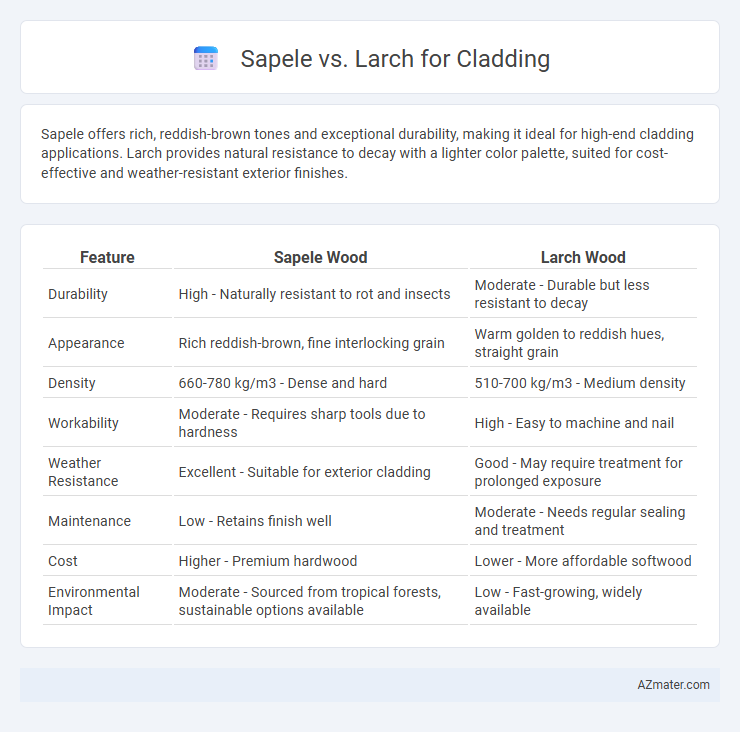Sapele offers rich, reddish-brown tones and exceptional durability, making it ideal for high-end cladding applications. Larch provides natural resistance to decay with a lighter color palette, suited for cost-effective and weather-resistant exterior finishes.
Table of Comparison
| Feature | Sapele Wood | Larch Wood |
|---|---|---|
| Durability | High - Naturally resistant to rot and insects | Moderate - Durable but less resistant to decay |
| Appearance | Rich reddish-brown, fine interlocking grain | Warm golden to reddish hues, straight grain |
| Density | 660-780 kg/m3 - Dense and hard | 510-700 kg/m3 - Medium density |
| Workability | Moderate - Requires sharp tools due to hardness | High - Easy to machine and nail |
| Weather Resistance | Excellent - Suitable for exterior cladding | Good - May require treatment for prolonged exposure |
| Maintenance | Low - Retains finish well | Moderate - Needs regular sealing and treatment |
| Cost | Higher - Premium hardwood | Lower - More affordable softwood |
| Environmental Impact | Moderate - Sourced from tropical forests, sustainable options available | Low - Fast-growing, widely available |
Introduction to Sapele and Larch Cladding
Sapele cladding, derived from the African Sapele tree, is prized for its rich reddish-brown hue and natural durability, making it a popular choice for exterior and interior applications. Larch cladding, sourced from the fast-growing Larch tree native to Europe and North America, offers a distinctive pale yellow to light brown color combined with high resistance to moisture and decay. Both Sapele and Larch provide unique aesthetic and performance characteristics that suit different architectural styles and environmental conditions.
Botanical Origins and Characteristics
Sapele (Entandrophragma cylindricum) is a tropical hardwood native to West Africa, prized for its rich reddish-brown color, durability, and fine interlocking grain that resists warping, making it ideal for exterior cladding. Larch (genus Larix), a temperate conifer native to the cool regions of North America, Europe, and Asia, is a softwood known for its natural resistance to rot and distinct pale yellow to reddish-brown heartwood with prominent knots and resin canals. The dense, oily nature of Sapele contrasts with the resin-rich, moderately soft texture of Larch, influencing their weathering properties and maintenance requirements in cladding applications.
Appearance and Grain Pattern Comparison
Sapele exhibits a rich reddish-brown hue with a fine, interlocked grain pattern that produces a smooth, lustrous finish ideal for elegant cladding designs. Larch showcases a warm golden-yellow to reddish-brown color with a pronounced, straight grain pattern accented by visible knots, offering a rustic and textured appearance for exterior siding. The choice between Sapele and Larch for cladding depends on whether a sleek, polished look or a natural, rugged aesthetic is preferred.
Durability and Weather Resistance
Sapele wood offers strong durability and excellent weather resistance due to its dense, interlocking grain and natural oils that prevent rot and insect damage, making it ideal for exterior cladding in humid or wet climates. Larch, while moderately durable, is naturally resistant to decay and moisture thanks to its high resin content but may require regular maintenance or treatment to maintain optimal performance against harsh weather conditions. Both species provide good weather resistance, but Sapele's higher durability and stability typically result in longer-lasting cladding with less susceptibility to warping or splitting.
Maintenance Requirements
Sapele wood cladding requires regular oiling to preserve its rich color and prevent weathering, making maintenance moderately intensive. Larch cladding offers natural durability and weathers to a silvery gray without treatment, reducing maintenance efforts over time. Both materials benefit from periodic inspections to address any signs of damage or decay for optimal longevity.
Sustainability and Environmental Impact
Sapele cladding, sourced from West African rainforests, presents sustainability concerns due to deforestation and slower regrowth rates, whereas larch, predominantly found in Europe and North America, offers a more eco-friendly option with its faster growth and greater availability from sustainably managed forests. Larch's natural durability reduces the need for chemical treatments, minimizing environmental toxins, while Sapele often requires preservation chemicals to enhance longevity. Choosing larch for cladding supports lower carbon footprints and promotes responsible forestry practices, making it a greener alternative compared to Sapele.
Cost and Availability
Sapele wood typically costs more than larch due to its exotic status and limited supply, impacting overall cladding expenses. Larch is widely available in Europe and North America, often resulting in lower prices and faster procurement times. Both woods offer durability, but budget-conscious projects favor larch for cost-effectiveness and accessibility.
Workability and Installation
Sapele, a tropical hardwood, offers excellent workability due to its fine grain and medium density, making it easier to cut, shape, and fasten during cladding installation. Larch, a softwood with high resin content, can be more challenging to machine but provides good dimensional stability and natural durability for exterior cladding. Sapele's smoother finish typically reduces installation time, while Larch requires more careful handling to avoid resin-related issues and ensure proper fastening.
Popular Uses in Modern Architecture
Sapele is favored in modern architecture for cladding due to its rich, reddish-brown color and fine grain, providing a luxurious and durable exterior finish that resists weathering. Larch, valued for its high resin content and natural durability, offers a more rustic, textured appearance ideal for contemporary eco-friendly designs and sustainable timber construction. Both woods are popular for their strength and aesthetic appeal, but Sapele suits sleek, high-end facades while Larch complements natural, organic architectural styles.
Final Verdict: Choosing Between Sapele and Larch
Sapele offers a rich, dark reddish-brown hue and exceptional durability, making it ideal for high-end cladding projects requiring a polished appearance and resistance to rot. Larch provides natural durability with a warm, golden tone and excellent weather resistance, suitable for sustainable and cost-effective exterior cladding. The final verdict depends on desired aesthetics and budget: choose Sapele for premium, elegant finishes and Larch for affordability combined with natural longevity.

Infographic: Sapele vs Larch for Cladding
 azmater.com
azmater.com